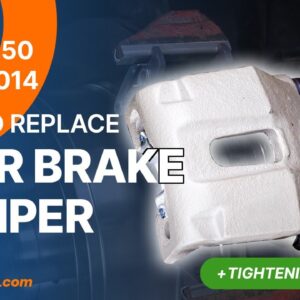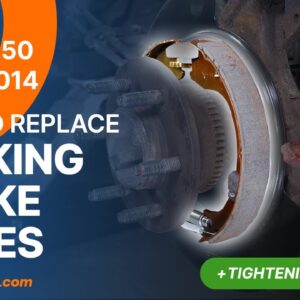Watch this video to learn how to replace the rear axle shaft on a 2009-2014 Ford F-150.
Replacing Rear Axle Shaft on a 2009-2014 Ford F-150: What You Need
Ready to perform this DIY replacement job? Remember that all the parts in this guide can be found on CarParts.com. Check out all the products that fit your vehicle right here.
Parts Checklist
- Rear axle shafts: Driver side and Passenger side
- Brake cleaner
- Differential fluid
Tightening Torques
- Pinion shaft lock bolt : 22 Ft-lbs.
- Differential cover bolts: 33 Ft-lbs.
- Lower slide pin and stop rubber balancer:
- 2009 through 2011 models: 22 Ft-lbs.
- 2012 and later models: 24 Ft-lbs.
- Rear brake flexible hose bracket bolt : 22 Ft-lbs.
Tools Checklist
Here’s the toolbox we recommend to repair your Ford F-150: HM85 85 Piece Ratchet and Socket Set
List of tools:
- Hydraulic jack
- Jack stands
- Wheel lug wrench
- Liquid collector
- Ratchet
- 10mm socket
- Flat head screwdriver
- 8mm wrench
- Small Hex wrench
- Torque wrench
- Razor blade
- Sandpaper
- Paper towel
- Silicone for gaskets
Step-by-Step Instructions
Step 1: Turn off the engine and engage the parking brake. Pull the hood release handle and open the hood. Open the brake fluid reservoir.
Step 2: Loosen the stud bolts on the rear wheels. Lift the rear of your vehicle and place it on jack stands.
Step 3: To change the rear axle shafts on your vehicle, remove the wheels for full access. Remember to place the wheels under the vehicle for safety.
Step 4: Remove the brake system to gain access to part of the rear axle shaft. Disengage the rear axle shaft from the differential.
Step 5: Place a fluid collection tray under the differential to catch the fluid.
Step 6: Using a ratchet and a 10-mm socket, unscrew the 10 bolts holding the differential cover. Use a flathead screwdriver to carefully remove the differential cover and let the fluid flow out for about 10 minutes.
Step 7: Set the gear shift lever to “Neutral” to access the pinion shaft lock bolt.
Step 8: Unscrew the lock bolt from the pinion shaft using an 8-mm wrench and remove it. Extract the pinion shaft by pushing it outward. You can reinsert the lock bolt to help remove it.
Step 9: Rotate the differential to access the retaining clip. Push the rear axle shaft toward the differential to remove the retaining clip using a hex wrench.
Step 10: Remove the rear axle shaft then insert the new rear axle shaft fully into its slot. Replace the retaining clip and push the rear axle shaft outward for the pinion shaft insertion.
Step 11: Rotate the differential to reinsert the pinion shaft. Reinsert the pinion shaft and tighten the lock bolt by hand, then with the 8-mm wrench. Finish tightening with a torque wrench.
Step 12: Clean the seal surface on the differential cover for a proper seal. Remove the used seal with a razor blade, scrub with fine sandpaper, clean with brake cleaner, and wipe with a paper towel. Repeat the same cleaning process on the differential cover.
Step 13: Thinly apply silicone gasket maker for a perfect seal on the differential. Replace the differential cover, hand-tighten the bolts, and finish tightening in a staggered order with a torque wrench. Carefully refill the differential with fluid.
Step 14: Replace the brake system and put the wheels back on your vehicle. Lower the car and properly block the wheels. Screw the brake fluid cap back on before starting the car.
Step 15: Before driving, start the car and pump the brake pedal a few times to press the brake pads together. Drive smoothly and avoid sudden braking for the first 30 miles to prevent glazing the new pads.
Compatible Vehicles
The operation and tools displayed in the video should be available on the following vehicles:
Important Reminders
Once the operation is completed, you’ll need pump slowly on the brake pedal a few times until feeling a strong resistance from the pedal. The aim being to bring the brake pads closer to one other.
Drive smoothly and avoid sudden braking for the first 30 miles or so, to avoid glazing the new pads. What do we mean by “glazing new brake pads”? Brake pads are made of a material that needs to be run-in when new. If this procedure is not done properly, when braking too hard, the material overheats and hardens. Consequently, the brakes become less effective.
In order to remove the rear axle shaft, you need to disengage it from the differential.
Before replacing the differential cover, you need to clean the seal surface to ensure a perfect seal.
Disclaimer:
This video is for entertainment purposes only. Carparts.com, Inc. disclaims all damages including, but not limited to, actual, consequential, and/or punitive, for any liability, claim, or any other injury or cause related to or arising from any information or lack thereof posted in this video. No information contained in this video shall create any expressed or implied warranty or guarantee of any particular result. All mechanical car projects entail some risk. It is the sole responsibility of the viewer to assume this risk. If you are in doubt, please consult a licensed mechanic in your area.
Any information provided on this Website is for informational purposes only and is not intended to replace consultation with a professional mechanic. The accuracy and timeliness of the information may change from the time of publication.













